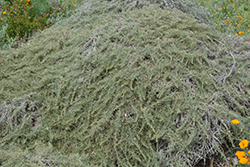It's all about ...
plants

Canyon Gray California Sagebrush
Artemisia californica 'Canyon Gray'
Height: 18 inches
Spread: 8 feet
Sunlight:
![]()
![]()
Hardiness Zone: 9a
Other Names: Coastal Sagebrush, Sage Brush
Description:
An aromatic shrub, that branches from the base, out to about 8 feet; finely divided, light gray-green leaves provide for a great landscape contrast; does best in poor, dry soils; an ideal plant for adverse conditions where little else will grow
Ornamental Features
Canyon Gray California Sagebrush has attractive grayish green foliage with hints of silver on a plant with a spreading habit of growth. The tiny fragrant threadlike leaves are highly ornamental and remain grayish green throughout the winter. The white stems are very effective and add winter interest.
Landscape Attributes
Canyon Gray California Sagebrush is a multi-stemmed evergreen shrub with a ground-hugging habit of growth. It lends an extremely fine and delicate texture to the landscape composition which should be used to full effect.
This shrub will require occasional maintenance and upkeep, and can be pruned at anytime. Deer don't particularly care for this plant and will usually leave it alone in favor of tastier treats. Gardeners should be aware of the following characteristic(s) that may warrant special consideration;
- Spreading
- Self-Seeding
Canyon Gray California Sagebrush is recommended for the following landscape applications;
- Mass Planting
- Rock/Alpine Gardens
- General Garden Use
- Groundcover
- Naturalizing And Woodland Gardens
Planting & Growing
Canyon Gray California Sagebrush will grow to be about 18 inches tall at maturity, with a spread of 8 feet. It tends to fill out right to the ground and therefore doesn't necessarily require facer plants in front. It grows at a medium rate, and under ideal conditions can be expected to live for approximately 30 years. As this plant tends to go dormant in summer, it is best interplanted with late-season bloomers to hide the dying foliage.
This shrub does best in full sun to partial shade. You may want to keep it away from hot, dry locations that receive direct afternoon sun or which get reflected sunlight, such as against the south side of a white wall. It prefers dry to average moisture levels with very well-drained soil, and will often die in standing water. It is considered to be drought-tolerant, and thus makes an ideal choice for a low-water garden or xeriscape application. It is not particular as to soil pH, but grows best in poor soils, and is able to handle environmental salt. It is highly tolerant of urban pollution and will even thrive in inner city environments. This is a selection of a native North American species. It can be propagated by division; however, as a cultivated variety, be aware that it may be subject to certain restrictions or prohibitions on propagation.
This plant is not reliably hardy in our region, and certain restrictions may apply; contact the store for more information.

